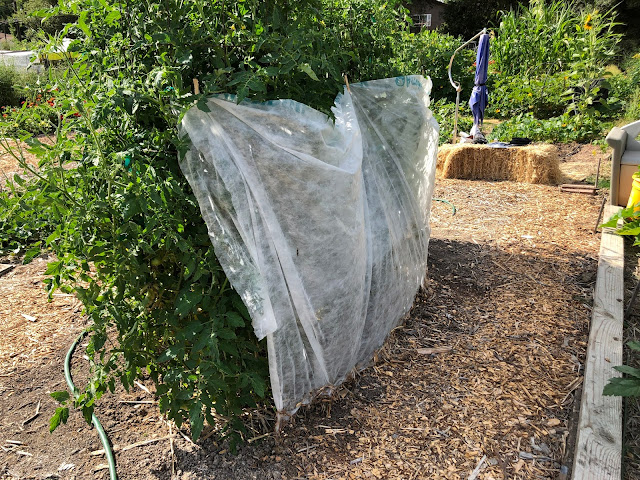
Record heat could fry plants

|
| Thin frost cloth is one solution to temporary shade for your tomatoes or other vegetables during a heat spike. (Photo: Kathy Morrison) |
Better find some shade. We may be heading into the hottest weekend in Sacramento history.
According to the National Weather Service, a heat dome – a phenomenon that recently cooked the Pacific Northwest – has clamped down over California’s Central Valley, rapidly ratcheting up our high temperatures to record levels.
The weekend forecast calls for two days above 110 degrees – possibly hitting 115 on Saturday. That’s more than 20 degrees above normal for early July.
That also would tie or break the record for Sacramento’s hottest day ever. Downtown Sacramento’s official all-time record is 114 degrees, set in July 1925. Executive Airport, Sacramento’s other official weather monitoring point, recorded 115 degrees in June 1961, says the weather service.
In more than 150 years of temperature watching, Sacramento has had only one weekend with back-to-back days of 110 degrees or higher. According to The Sacramento Bee, that was last summer – Aug. 15 (111 degrees) and Aug . 16 (112), 2020.
Overnight lows will not give much relief. Instead of dipping down into the low 60s or 50s, nighttime temperatures will remain mostly in the 80s, cooling off to 70s after midnight.
It’s not until Tuesday when weather patterns return to normal and days are just plain hot instead of broiling. Tuesday’s forecast calls for 94 degrees and a refreshing low of 59 degrees.
What does that mean for your garden? The weather service calls this extreme heat “dangerous,” and it can be catastrophic for under-hydrated plants as well as people or pets.
Get out in the early morning to handle any garden tasks. No. 1 on your list: Water.
First, check your soil moisture. Some parts of your landscape may be coping just fine and don’t need the extra hydration. Use a moisture meter or take a trowel and just look, digging down about 6 inches. Or just try to push a long screwdriver into the dirt. If the soil is hard and dry, it needs water – now! Deep-water trees, shrubs and perennials as well as vegetables.
When watering from a hose, run a little water out of the hose first (into a bucket if you prefer) before turning it on your plants to avoid scalding their foliage. This is especially important for watering in the late afternoon or evening. Water inside the hose itself can be more than 140 degrees on triple-digit days. (Water in the bucket can be used after it cools.)
Some plants show they’re thirsty; they wilt. The larger the leaves, the more they wilt. Afternoon wilt is normal for many squash or melons, but if they’re still wilted in the morning – they need water.
In the ornamental garden, hydrangeas and hardy hibiscus tend to be most in need. Make sure they're mulched as well as watered.
Think twice before deep irrigating fruit trees heavy with ripening peaches or other summer fruit. Too much water may get sucked up into that ripening fruit and may break branches or even split the tree.
Instead, consider harvesting at least some of the fruit to take strain off the tree. Otherwise, the tree may just drop its crop.
Speaking of which, pick up any dropped fruit; it will quickly rot in this heat.
Keep an eye on container plants. Any potted plant will need more water, perhaps daily. Again, check the soil first.
If you haven’t already, elevate potted plants off hot concrete, asphalt or other hardscape. Place a piece of thick cardboard or wood under the pot to insulate it from the hot surface underneath. If possible, move sensitive plants into shadier areas.
Make some (temporary) shade for peppers, tomatoes, eggplants and other ripening vegetables. They can get sunburned quickly. Keep these vegetables (plus squash, melons, pumpkins, etc.) evenly hydrated to avoid blossom end rot.
Don’t fertilize when it’s hot; it can do more harm than good.
One good thing about this heat: The grass doesn’t grow. Water the lawn in the morning (twice a week), but put off mowing. Another plus to delayed mowing: Longer grass blades shade their roots and help them cope with intense heat (and less water).
In weather like this, even grass appreciates some shade.
Comments
0 comments have been posted.Sacramento Digs Gardening to your inbox.
Sites We Like
Garden Checklist for week of July 21
Your garden needs you!
* Keep your vegetable garden watered, mulched and weeded. Water before 8 a.m. to reduce the chance of fungal infection and to conserve moisture.
* Feed vegetable plants bone meal, rock phosphate or other fertilizers high in phosphate to stimulate more blooms and fruiting. (But wait until daily high temperatures drop out of the 100s.)
* Don’t let tomatoes wilt or dry out completely. Give tomatoes a deep watering two to three times a week.
* Harvest vegetables promptly to encourage plants to produce more. Squash especially tends to grow rapidly in hot weather. Keep an eye on zucchini.
* Pinch back chrysanthemums for bushy plants and more flowers in September.
* Remove spent flowers from roses, daylilies and other bloomers as they finish flowering.
* Pinch off blooms from basil so the plant will grow more leaves.
* Cut back lavender after flowering to promote a second bloom.
* It's not too late to add a splash of color. Plant petunias, snapdragons, zinnias and marigolds.
* From seed, plant corn, pumpkins, radishes, winter squash and sunflowers.